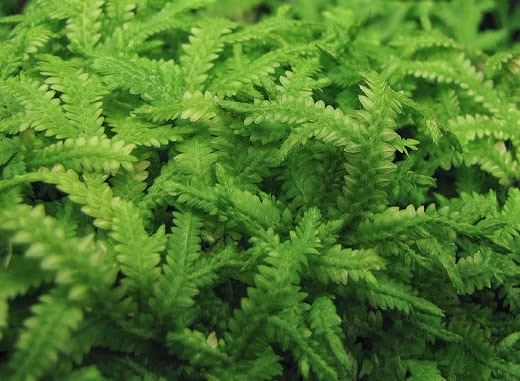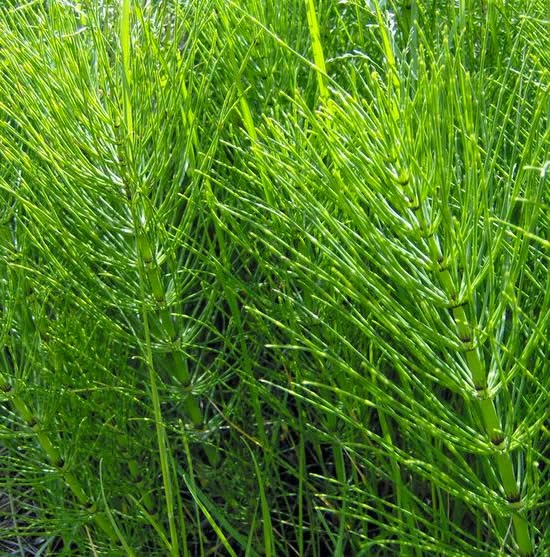 |
| Seedless Vascular Plants |
Seedless vascular plants possess vascular tissues (xylem and phloem) for transport of materials through the body but do not produce seeds bearing dormant embryos as part of the reproductive process. They are among the oldest of land plants.
Modern seedless vascular plants include species from several different phyla, including the club mosses, spike mosses, and quill worts of the phylum Lycophyta, the horsetails of the phylum Sphenophyta, the whisk ferns of the phylum Psilotophyta, and the great diversity of ferns in the phylum Pterophyta. Lycophytes, sphenophytes, and psilotophytes are generally referred to as fern allies.
Carolus Linnaeus used theword Cryptogamia (from the Greek kryptos, meaning “hidden,” and gamos, meaning “marriage,” or reproduction) as an inclusive taxonomic category for a wide range of organisms such as bryophytes, ferns, fern allies, algae, and fungi whose sexual reproductive parts were concealed from observation. The term cryptogam in modern usage refers to plants that do not produce seeds.
  |
Origin and Relationships
Theories on the origin of vascular plants suggest that they probably arose from an ancestor in the group of nonvascular plants known as the bryophytes.
Fossil spores from the Ordovician period (about 500 million years ago) are linked to the earliest land plants, which were likely an early liverwort (phylum Hepatophyta) or hornwort (phylum Anthocerophyta). The most derived bryophytes, the mosses (phylum Bryophyta), share an ancestor with the line that gave rise to vascular plants.
Aline that gave rise to the phylum Lycophyta appears to have diverged early in vascular plant development, soon after the advent of phloemand the rise of the dominance of the branching sporophyte generation. The remaining line diverged into a branch that gave rise to modern sphenophytes (horsetails) and pterophytes (ferns) and a branch that gave rise to modern seed plants.
Seedless vascular plants are well represented in the fossil record. Cooksonia, a representative of the extinct phylum Rhyniophyta, is thought to be one of the earliest vascular plants, dating to the mid Silurian period (around 430million years ago). Numerous other examples dating to the Devonian period (around 400million years ago) are well documented.
Life Cycle and Gametophyte Anatomy
 |
| Equisetum arvense |
Seedless vascular plants express the typical life cycle pattern called alternation of generations found in many algae and members of the kingdom Plantae. As in all vascular plants, the diploid sporophyte generation, which produces haploid spores for the asexual reproductive phase, is dominant. Haploid spores are produced by meiosis in special structures called sporangia (singular, sporangium).
In psilotophytes, some lycophytes, the sphenophytes, and the pterophytes, only one kind of spore is produced in a phenomenon called homospory. Sexually reproducing haploid gametophytes that have both male and female sex organs arise from these spores.
In some lycophytes, two kinds of spores are produced in a phenomenon called heterospory. Large spores called megaspores are produced in megasporangia. Megaspores develop into female gametophytes. Small spores called microspores are produced in microsporangia. Microspores develop into male gametophytes.
The haploid gametophytes of seedless vascular plants, which produce gametes (sex cells) for the sexual reproductive phase, are independent and smaller than the sporophytes.
   |
Gametophytes range in size from a few millimeters to a few centimeters in length or diameter,while sporophytes can range in size from a few millimeters to several meters in height. Since there is a distinct difference between the appearance of the sporophyte and the gametophyte, these organisms are said to express heteromorphy.
In psilotophytes and some lycophytes, gametophytes are nonphotosynthetic and underground, while in most of the other groups gametophytes grow on the soil surface and are photosynthetic. Underground gametophytes must rely on mutualistic fungi in mycorrhizal relationships to supply them with energy and carbon sources for growth and development.
Gametes are produced by mitotic cell division. Male gametes are produced in organs called antheridia (singular, antheridium). Sperm cells are multiflagellated and require liquid water for transmission to the female organs of a nearby plant. Eggs are produced in organs called archegonia (singular, archegonium).
Sperm cells swim through the neck of the archegonium and into a swollen region at the base called the venter, which contains the egg. Fertilization results in the production of a diploid zygote, which develops into an embryo that then grows into a sporophyte.
Sporophyte Anatomy
 |
| Psilotum nudum |
According to the fossil record, the earliest vascular plants were quite similar in structure to the modern genus Psilotum, of the phylum Psilotophyta: the whiskferns. The Psilotum sporophyte lacks true leaves and roots (that is, the organs lack vascular tissue).
Small, nonvascularized flaps of tissue called prophylls are found on the stem of Psilotum, which some theorize either are reduced leaves or may be suggestive of the evolutionary origin of leaves—that is, that true leaves are the result of the evolutionary vascularization of prophylls. The other living psilotophyte genus, Tmesipteris, possesses true leaves, each with a single vein, referred to as microphylls.
Other groups produce either the one-veined microphylls or megaphylls that have numerous, often branched veins. The most dramatic leaf expression in seedless vascular plants is found in the delicate, pinnately compound, megaphyllous fronds of many of the ferns in phylum Pterophyta.
In lycophytes, sporangia are produced on specialized leaves called sporophylls. Some interpret the spore-bearing sporangiophores that make up the cones of sphenophytes to be specialized leaves, as well.
The aerial stem of Psilotum exhibits a primitive pattern of isotomous dichotomous branching, with two equal branches arising from one branch point, or node. Other seedless vascular plants may show different patterns: For example, lycophytes often show an unequal dichotomous branching pattern, or anisotomy.
In most cryptogams, aerial stems arise from underground stems called rhizomes. Rhizomes of psilotophytes have many rhizoids, rootlike epider mal extensions, to aid in absorption of water and mineral nutrients. The sporophytes of all other groups of seedless vascular plants possess vascularized roots for absorption and anchorage.
The vascular tissues of all members of this broad group include the primitive type of xylem called tracheids and the primitive type of phloem called sieve cells. The vascular cylinder, or stele, of Psilotum is composed of a solid core of xylem surrounded by a layer of phloem.
This arrangement is called a protostele. Variations on the protostele pattern are common in the roots, rhizomes, and shoots of members of the Lycophyta. Protosteles are the most common stele types found in vascular plant roots, in general.
The shoot steles of sphenophytes and pterophytes are composed of a ring of xylem surrounding a pith made of parenchyma tissue. A ring of phloem surrounds the xylem ring.
This arrangement is called a siphonostele. Variations on the siphonostele pattern are common in the shoots of all vascular plants from the sphenophytes through the seed plants.
The endodermis is a layer of cells that surrounds the vascular cylinder of roots and rhizomes and some shoots in certain psilotophytes; it is is usually localized in the roots and rhizomes of lycophytes, sphenophytes, and pterophytes. The waterproofing suberin deposited in the Casparian strip of the endodermis regulates water flow to the vascular tissue.
Lycophyta
 |
| Lycophyta |
Fossil evidence suggests that the phylum Lycophyta, the lycophytes, arose during the Devonian period. There are between ten and fifteen genera, consisting of about one thousand species, divided among three broad groups: the club mosses of the order Lycopodiales, the spike mosses of the order Selaginellales, and the quillworts of the order Isoetales.
All possess microphylls; however, the homosporous clubmosses differ significantly from the heterosporous spike mosses and quillworts.
Some extinct lycophytes were woody and grew to tree size. Lycophytes were among the dominant species during the Carboniferous period (around 350 million years ago), during which the plants that eventually became coal deposits were produced.
Sphenophyta
 |
| Horsetail - Sphenophyta |
Phylum Sphenophyta arose during the Devonian period and reached its peak during the late Devonian and Carboniferous periods.
Among the largest sphenophytes were members of the genus Calamites, treelike plants that exceeded 18 meters (60 feet) in height and nearly 0.5 meter (18 inches) in basal stem diameter. There are fifteen living herbaceous species in the only remaining genus, Equisetum, the horsetails.
Psilotophyta
The fossil record is incomplete regarding the ancestry of modern psilotophytes, so it is difficult to assign a date of origin. Although once considered to possess characteristics that allied them to the most primitive vascular plants, molecular studies have suggested that psilotophytes are possibly closely related to pterophytes (ferns), perhaps representing a reduction from an early fern ancestor. The phylum includes only two living genera, consisting of a total of six to eight species.
Pterophyta
Pterophytes, or ferns, arose during the Devonian period and reached the height of abundance and diversity during the Carboniferous. Today, there are about eleven thousand species of ferns ranging in size from a few millimeters across (such as Azolla) to several meters in height (such as Dicksonia).
Excluding flowering plants, ferns are the most abundant and diverse plants on earth, exhibiting a variety of growth habits, from floating aquatics to tropical epiphytes to temperate terrestrial plants. They are important both ecologically and economically, serving as habitat and food sources for many organisms. Humans use ferns as food, fuel, and decoration.